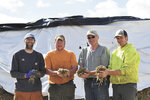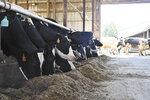


Describe your farm and facilities. We are a multi-generational farm that was started in 1861. The owners and operators of the business include Jim and Donna Hoefs and their sons — Jim, Jason and Joel. We sell our milk to Agropur in Le Sueur. Most of the livestock is housed on the main farm site. Our milking herd is housed in free stalls and milked in our double-8 parlor. We raise all of our youngstock and replacement heifers. As part of the operation, we also finish out all our steers. We produce the majority of our forage on acres that are close to the farm.
What forages do you harvest? We harvest winter rye in the late spring to be utilized in dry cow and heifer rations. Alfalfa is harvested four times throughout the summer and utilized in our lactating cow ration. Our corn silage crop is harvested in September and utilized in all our animal diets. Grass meadows and ditches are harvested and wet wrapped for use in dry cow and heifer rations.
How many acres of crops do you raise? We farm approximately 1,000 acres of cropland. We raise corn, soybeans, spring wheat, alfalfa, barley and peas, new seeding alfalfa cover crop and winter rye.
Describe the rations for your livestock. We mix four different types of rations. Our lactating cow ration is composed of corn silage, haylage, alfalfa baleage, cottonseed, soybean meal and mineral mix. The dry cow ration utilizes some of our lower-quality forages including ryegrass baleage, low-quality alfalfa baleage, corn silage, distillers grain and mineral mix. The heifer ration is similar to the dry cow ration in composition but utilizes a different mineral mix. We also mix a ration for our steer finishing lot that is much lighter in forage but utilizes low-quality forages such as grass to help balance their diet of primarily corn and distillers grain.
What quality and quantity do you harvest of each crop? We harvest approximately 3,800 tons of corn silage annually. We try to optimize quality by harvesting at ideal moisture of 68%. For haylage/baleage we run approximately 155 acres of alfalfa annually. We harvest 4-5 crops each year depending on conditions. We harvest approximately 65 acres worth of ryegrass cover crop. This past year it was nearly 900 round bales that varied in quality because of challenging harvest conditions. We also harvest meadow grass. We aim to harvest at least 1,000 grass bales that vary in quality and moisture.
Describe your harvesting techniques for alfalfa and corn silage. We recently purchased a self-propelled chopper that has changed the way our forage harvesting is handled. Our chopping wagons have been retrofitted to be able to continue using them with the self-propelled chopper. More than half our alfalfa crop is chopped into a silo or bunker. The remaining alfalfa is round baled and wet wrapped to be fed as baleage.
Corn silage is harvested in early fall each year. We aim to harvest at 68% moisture and fill multiple bunkers to put up about 13 months’ worth of feed each year.
What techniques do you use to store, manage and feed your forages. We have four bunkers of varying sizes that store our corn silage and haylage crops. Bunkers are well packed to maximize the amount of forage stored and the quality of feed we produce.
We maintain three Harvestore silos and two stave silos for storage of haylage and high moisture ear corn.
A large portion of the back of the farm site is used to store individually wrapped alfalfa, rye and grass round bales. Individually wrapping allows us to stack bales three high to minimize the footprint for feed storage. Most forages are mixed into rations for youngstock, milking cows or dry cows.
How does quality forages play in the production goals for your herd? We strive to produce milk high in components and feed accordingly. Harvesting our forages at ideal times and with short harvest windows allows us to put up feed that is higher in quality. This quality forage helps us to minimize the costly inputs needed to balance our rations for all of our livestock.
What are management or harvesting techniques you have changed that has made a notable difference in forage quality? Explain. When we switched to baleage many years ago, it ensured being able to produce a quality forage even when the weather didn’t cooperate. The addition of bunkers made forage production more labor and time efficient. Bunkers help us reduce the harvest window to ensure forages are put up at the highest possible quality. The addition of the self-propelled chopper added additional speed and efficiency to our haylage crops and allowed us to harvest corn silage exactly when we wanted to rather than waiting on the schedule of a custom chopping crew.
Describe a challenge you overcame in reaching your forage quality goals. Weather is always a factor when trying to put up good quality forage. With running 155 acres of alfalfa, it can be challenging to make sure all acres are cut and harvested within the sometimes-small dry weather windows Minnesota summers give us.
This past year specifically, we saw major challenges in harvesting our 65 acres of ryegrass cover crop. The spring was wet, the crop was thick, field conditions were awful and the weather didn’t cooperate. It was harvested over a two-week time span, using multiple techniques. By the end of the crop, we conceded to round baling the remaining crop to use as bedding.
Comments
No comments on this item Please log in to comment by clicking here